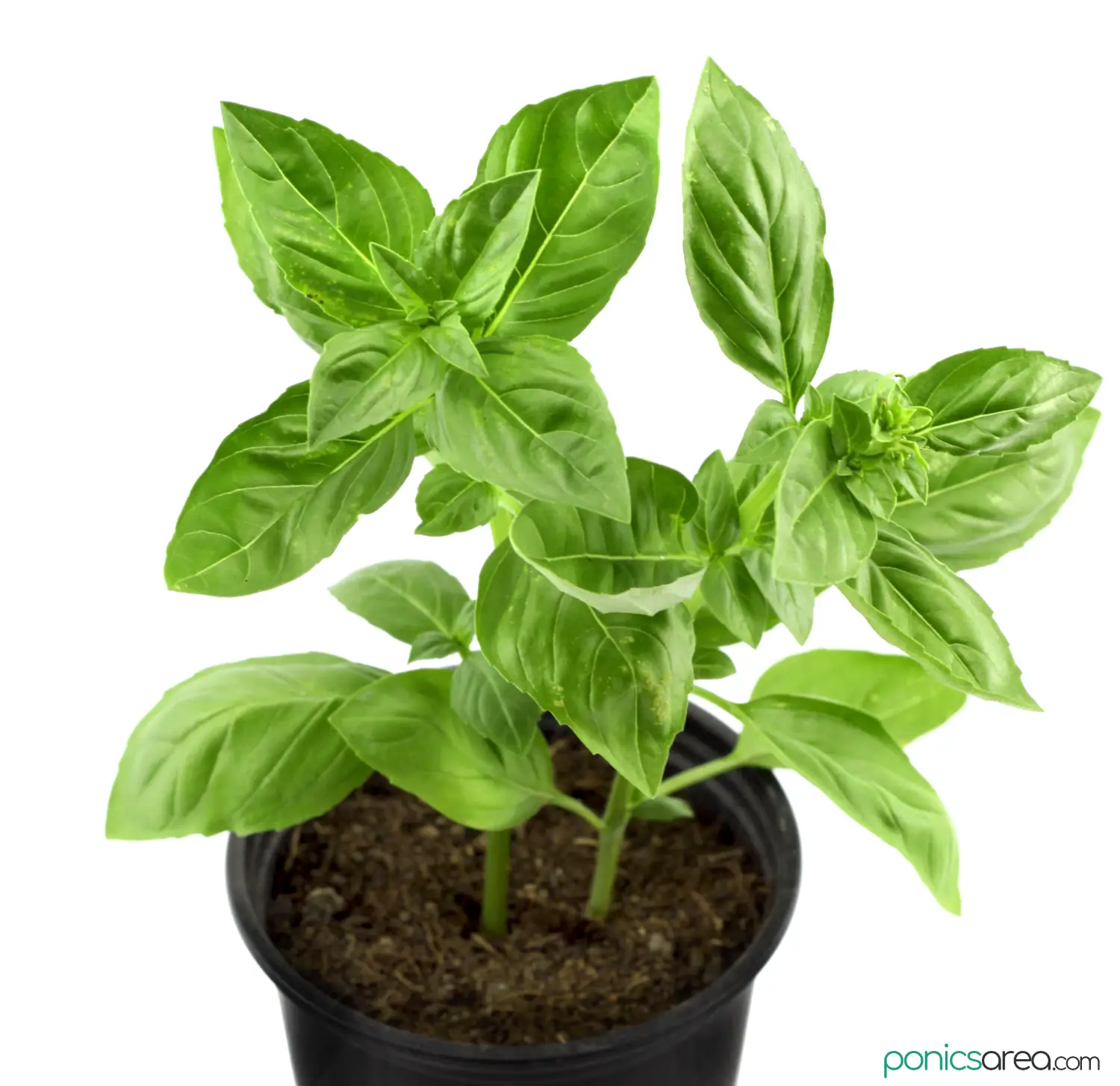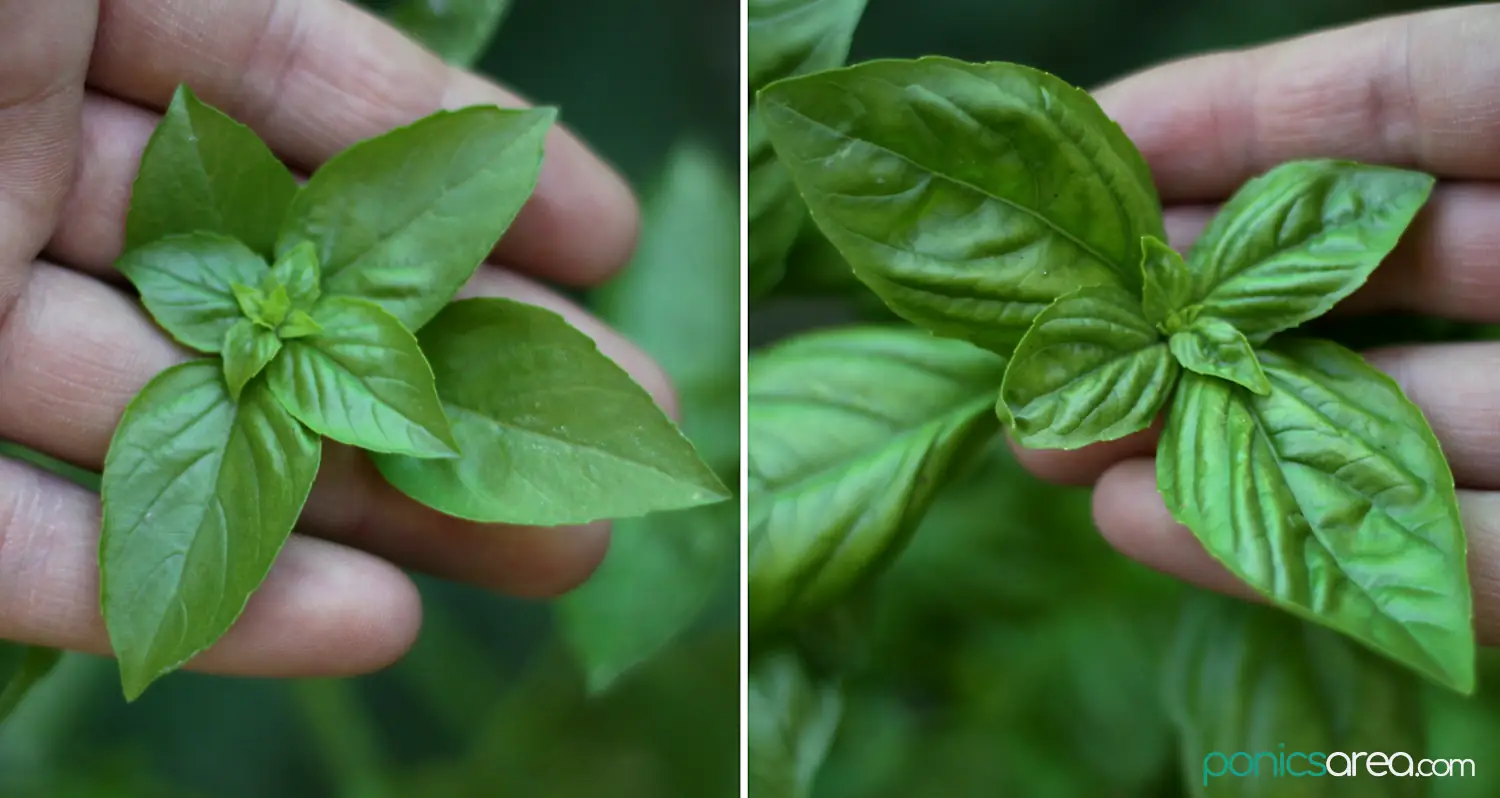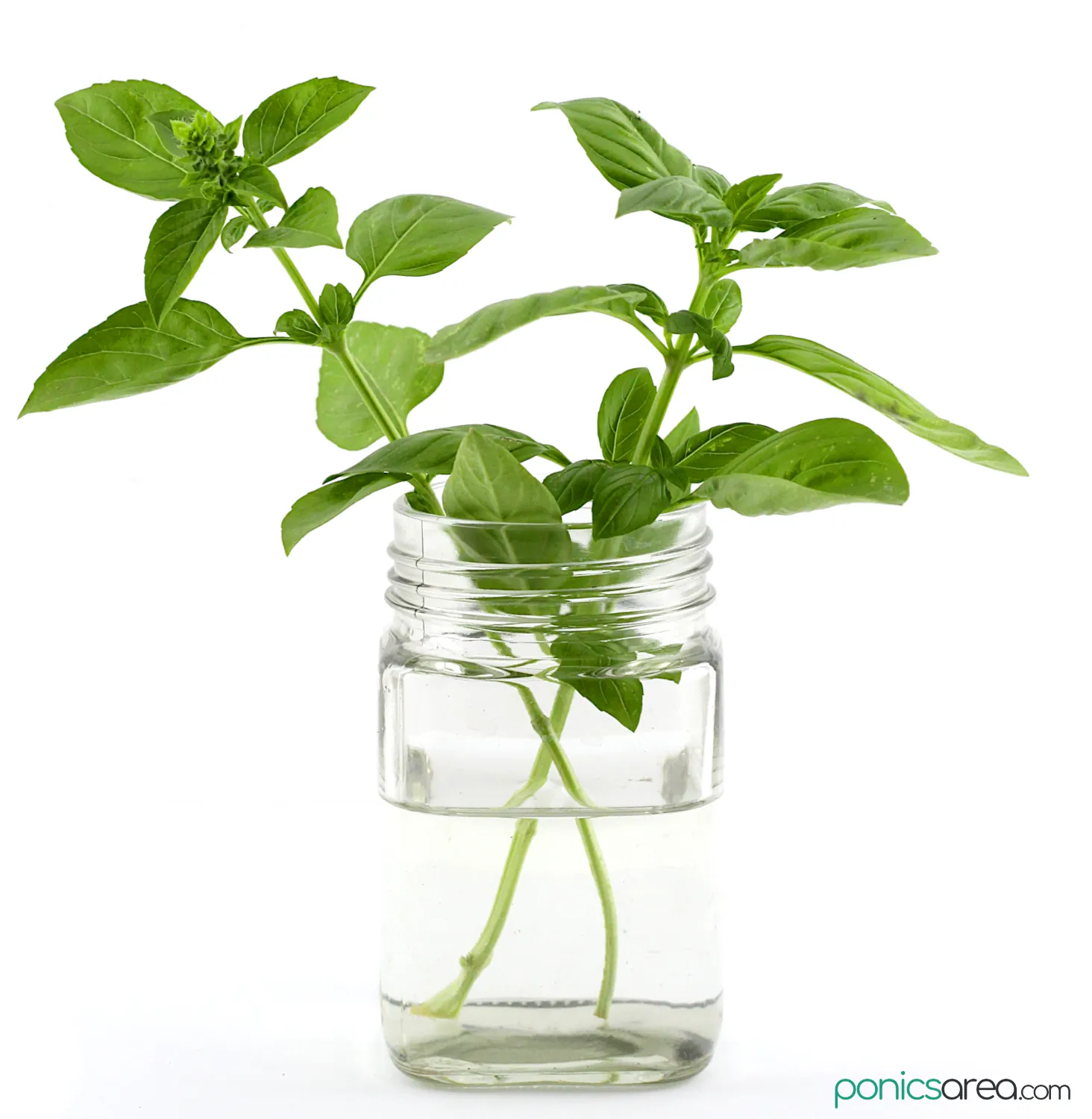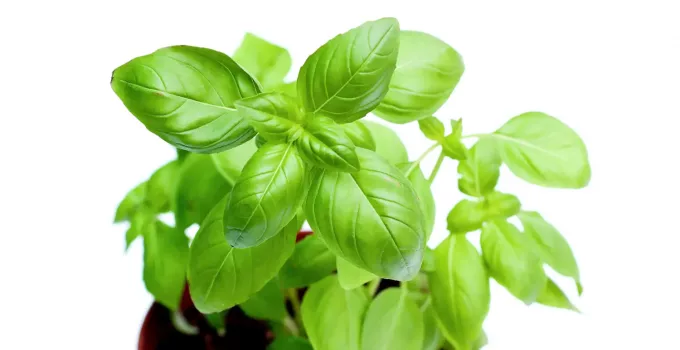You need to learn how to grow basil from seed indoors if you want to have fresh basil all year round. Growing basil, whether indoors or outdoors, is one of the easiest things you’ll ever do. It will also be immensely rewarding and exciting.
Let’s learn about the two different ways in which you can grow basil from seed: potted and in the garden.
There’s actually a third option for growing basil from seed. Some of you might not have heard of it but it’s always fun to discover new things. I’m talking about growing in a hydroponic system. You can learn more about that in my post on hydroponic basil.
Table of Contents
How to Grow Basil from Seed: What You Need
1. Seeds: Basil Seed Packet Collection
Sweet basil is the most popular variety because it’s the one most frequently used for cooking. Thai basil is another option is you prefer this cuisine the most. This pack bundle contains 8 varieties, it covers everything.
2. Containers: Plastic Plant Pots with Tray, 8″
If you don’t want to buy any pots, you can just sow the seeds in plastic containers that you have in your house. Just make sure that they have a good depth. My top recommendation is an 8-inch pot but you can start in a 6-inch one, too.
3. Potting soil: Miracle-Gro Indoor Potting Mix
This is an amazing choice but you can also make your own mix for growing basil from seed from: one third potting soil with one third organic matter one third vermiculite or perlite.
How to Grow Basil from Seed Indoors in 4 Steps

First, we’ll talk about the supplies that you need in order to grow basil from seed indoors in a pot or other type of containers. Then, we’ll see exactly how the process goes.
There are just a few steps that we need to cover if you want to know how to grow basil from seed.
What You Need to Grow Basil from Seed in Pots
1. Seeds
If you can, try to get fusarium tested seeds to prevent your plant from suffering from fusarium wilt, a fungal disease that can lead to wilting of a basil plant and to basil leaves turning yellow.
2. Pot/Container
An 8 inches (20 cm) pot is the best choice but you can also grow it in a 6-inch pot (these dimension apply to a large variety of herbs).
The pot needs to have good drainage to avoid root rot.
If you don’t want to spend money on buying a pot, you can use old plastic containers, just make sure they’re pretty large or just sow less seeds to avoid overcrowding.
If you don’t have much space at all but you still want to know how to grow basil from seed, you can grow it in plastic bottles – this website actually offers 17 different ways for growing herbs in plastic bottles.
Check out my reviews for the best containers for mint if you want more options.
3. Potting soil or potting mix
The best potting soil for basil is one that’s nutrient-rich, slightly acidic and well drained or a soil with lots of compost (organic matter).
4. Grow lights (optional)
You will need grow lights if you don’t have access to 6-8 hours of sunlight.
If you can’t place the pot in a sunny window, you can go for fluorescent grow lights if you don’t want to spend too much (full-spectrum LEDs are better but more expensive).
Grow Basil from Seed Indoors in 4 Steps

The ideal indoor temperature for potted basil is 70 to 90 degrees Fahrenheit (21.1-32 degrees Celsius). It’s quite the range, which allows us to grow it all year round.
It works for everyone, even for those living in apartments. That’s actually the beauty of growing all kinds of herbs.
Step 1: Plant 2-3 seeds 1/4 inches deep. You don’t have to actually measure the distance between the seeds, they just need to be comfortably spaced out.
Step 2: Place the pot on the window sill or outdoors in the sun. It needs 6-8 hours of sunlight. If that’s not possible where you live, you absolutely need to use grow lights for 10-12 hours per day.
Step 3: During germination, use a sprayer/plant mister to keep the soil moist.
Step 4: Thin out the weaker seedlings when the seedlings have 2 pairs of true leaves. That’s why I said that you don’t need to space the seeds a certain number of inches apart. The plants should end up being 6-8 inches apart.
Do self watering pots work for basil?
I would actually recommend a self-watering pot for a herb like basil, which likes its soil to be moist but not soggy. It will actually thrive in a self-watering pot. You can see here how that works.
I wouldn’t recommend self watering pots for drought-tolerant herbs like rosemary, lavender, and thyme. These are herbs that like their soil to get dry before it gets moist again. Self-watering pots are more suitable for herbs like basil, mint, chives, and parsley.
This is an extremely important fact to remember about basil plants: they don’t like soggy soil. They like moist soil with very good drainage.
Overwatering can lead to root rot, which can kill the plant.
How to Grow Basil from Seed Outdoors

The thing with knowing how to grow basil from seed in the garden is that you simply have to wait until the weather warms up.
You need to wait until the soil is warm (65 to 75 degrees). These are ideal soil temperatures for most plants and our herb is not and exception.
Cold temperatures will stunt its growth.
To get a jump on the season, you can germinate the seeds indoors.
Once you transplant the seedlings into the ground, in sunlight and in proper soil, the plant will reach 6 inches tall in about a month. When it reaches 6 inches tell, it’s time to prune it for the first time.
How to Plant Basil in the Garden in 4 Steps
You can also plant basil directly in the ground, as long as you wait for the weather and soil to warm up. Let’s see which are the steps for that.
Step 1: Buy the seeds for whatever basil variety (varieties) you plan on growing in the ground.
Step 2: Choose your spot in the garden. Basil grows best in fertile well-drained soil in a warm spot. You can plant it near tomatoes or near other herbs.
Step 3: Sow 2-3 seeds 1/4 inches deep and 10-12 inches apart. The same numbers apply for seedlings. If you have 3 or 4 plants growing, it can be enough for a small family.
Step 4: Once the seedlings appear and continue to grow and gain strength, avoid overhead watering to prevent fungal disease.
How long does it take to grow basil from seed?
Basil germinates in about 7 to 10 days after planting the seeds.
After that, the rhythm in which the plant grows depends on what you offer it. If it has warmth, water, sunlight, and a rich potting soil, then it will grow quite quickly.
A basil plant can grow, on average, in about 3 to 4 weeks. Others will grow big enough in 35 days.
But it can also take weeks until the plant is tall enough for its first pruning. It really depends.
Once the leaves have grown big enough, you should feel free to pick off leaves whenever you want to use them in a dish.
However, my first major harvest of basil leaves is when the plant is about 6 inches tall (approx. 15 cm). That’s when we should first prune our basil plant. The plant will have 3-4-5 sets of true leaves.
Pruning means cutting off the central stem to push the plant into growing two central stems. You will be cutting a bit more than half of the central stem.
My advice is to watch a video on how to prune a basil plant because it’s the easiest way to understand what you have to do.
This is the best method to ensure that our plant continues to grow new stems. It will lead to a more plentiful growth with lots and lots of basil leaves. It also postpones flowering, which means that pruning a basil plant is just as essential as knowing how to grow basil from seed.
How to Germinate Basil Seeds

If you want to know how to grow basil from seed in the garden, you might first want to learn about germinating basil seeds.
You can start the germination 3-4 weeks before planting time.
You will need either of these:
- germination kits – they’re pretty cheap and provide you with everything you need: seedling trays with quite a lot of cells, humidity vented domes, plant labels, and some can even come with heat mats; they’re especially helpful if you want to germinate different types of seeds at the same time since the trays have so many cells
- rockwool cubes – they’re cheap and some of the most popular grow media for germinating seeds of all kinds, especially for hydroponics systems, but they’re not biodegradable
There’s no need to soak the basil seeds before germination. That’s usually a practice reserved for seeds with a tougher exterior.
How to use germination kits
If you’re using germination kits, you’ll have to add seed starting potting mix. You can buy the potting mix for seedlings or you can make your own from two parts compost, two parts coco coir and one part perlite.
Once you have your cells filled with seed starting mix, you just need to sow 2-3 seeds per cell, planting them 1/4 inches deep.
Moisten the soil with a sprayer. Keep the soil moist but not soggy throughout the entire germination period.
Put on the dome and you can place the tray on a heat mat, if your kit comes with one.
Remove the dome when the seedlings appear. That should take place in about a week and in another 2-3 weeks they can be ready for transplanting in the garden or in a pot.
Trim the weaker seedling, keeping just the strong one with 2 sets of true leaves.
You can also wait for another 2-3 weeks to do the transplanting, until the seedlings grow stronger.
How to germinate basil in rockwool cubes
In my opinion, rockwool cubes are very easy to use:
- place the cubes in water and let them soak for about a minute
- place the cubes in the sink to let the water drain for about 15 minutes
- add 2-3 seeds per cube
- pinch the hole shut or add some vermiculite on top
- spray the seeds with a bit of water, a spray per cube is enough
- you can place the cubes with the seeds in a standard growing tray with a humidity dome or you can improvise a container with a dome all on your own
- 70-80 degrees F is the temperature you need to maintain
- once the seedlings appear, you can remove the dome
- you can water the cubes from below by simply adding a bit of water into the tray, the cubes will soak up what they need, you can remove the excess
- water the cubes once a day or once every 2 days, it depends how soon they dry out
- the seedlings should appear in about a week – trim the weaker seedling but don’t remove it entirely
- after about a week, you can place the seedlings under grow lights or outside in the sun to strengthen them
- you can transplant them in another 2 weeks
What if you don’t want to germinate basil seeds?
I must tell you that you can definitely skip this step entirely. It’s not necessary to germinate the seeds.
You can simply sow the seeds in the soil or in the ground.
If you want to learn how to grow basil from seed indoors, then I already told you everything you need to know above. You don’t need to germinate them, you can sow them directly in the potting soil/mix.
But if you want to grow basil in the garden without germinating the seeds indoors, then you will have to wait until the soil is warm (65 to 70 degrees).
The germination indoors helps because it can give you a jump on the season but that’s about it.
How to Grow Basil from Seed: Varieties

Sweet basil
Genovese, Italian Large Leaf, common basil, sweet basil is the most-known, most-planted variety around the world.
This is the one we use for most of our cooking, for making Italian dishes, salads, soups, and the amazing pesto.
Thai basil
Just as its name suggests, if you love Thai food, you’ll want to grow a lot of pots or bushes of this variety.
Just remember that it’s more quick to bolt (flower) than other varieties.
Lemon basil for a citrusy undertone
Greek basil
Has a punchy, aromatic flavor, it’s like a mix of mint and cloves and basil.
It’s just wonderful and the leaves are completely different from sweet basil, it’s a beautiful plant.
You can use it for the same dishes you would use sweet basil for.
Purple basil
It’s not exactly grown for cooking since it’s less potent than the Genovese variety, it can be considered more of an ornamental herb. But what a beautiful plant.
Alternatives to Growing Basil from Seed
There are a couple of things you can do if you want to avoid learning how to grow basil from seed entirely. They’re both awesome.
Buy a live basil plant
There is one very easy alternative to growing basil from seed, an alternative that lets you skip a lot of steps.
I’m talking about buying a live basil plant, a supermarket herb, and make it flourish in your home for many months to come. If you take care of it, it will continue grow until basil flowers.
Those supermarket herbs come in very small pots. So, one of the things you should consider when buying a live basil plant is transplanting it into a pot with good potting soil.
In order to repot a supermarket basil plant:
- grab a bigger pot/container – you can also use a self-watering pot if you have one
- the pot needs to have drainage holes
- fill it about half with potting soil/mix
- place the basil roots into the pot
- gently cover them with soil until the pot is nicely filled
- water the soil well and place it in the sunlight on the windowsill or outdoors
Propagate basil from cuttings

This is another easy alternative to knowing how to grow basil from seed indoors or in the garden.
The advantage is that the basil stems, the cuttings that you want to plant, already have true leaves and are quite developed. What I’m trying to say is that, once transplanted, these cuttings will become full mature herbs in a short period of time.
If you’re transplanting in a bigger pot, a 12 inch pot for example, you can add 3 cuttings per pot. An 8 inch pot can fit 2.
It’s incredibly easy if you know someone who can spare some cuttings.
Another option is to cut the stems to grow new plants once your herb starts flowering. When basil bolts, its growing cycle stops and the leaves can become slightly bitter.
You can also cut the stems from a store basil plant.
In order to propagate basil from cuttings, you just have to place the stems in jars/plastic bottles with water. The jars with the cuttings should be placed in sunlight or on the windowsill. You should change the water frequently.
After that, you can transplant the cuttings in about 2 weeks or when the roots are 2 inches (5 cm) long. It’s really easy and a fast alternative to learning how to grow basil from seed indoors or in the garden.




